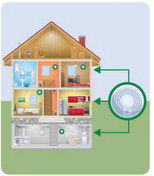The State Of Smoke And CO Alarms In U.S. Homes


Key Smoke Alarm Safety Tips And Guidelines
When working smoke alarms are present in your home, the risk of dying in a home fire is cut by 60 percent, according to the latest NFPA research. But how often are smoke alarms used in the United States, are they used properly, and what are people’s perceptions of them?
In September 2024, the U.S.
Consumer Product Safety Commission published the results of a comprehensive survey that assesses the prevalence, functionality, and public perception of smoke and carbon monoxide alarms in U.S. households.
The CPSC survey, known formally as the Survey on Use and Functionality of Smoke and Carbon Monoxide Alarms in Households, is a continuation of a similar study conducted by the CPSC 30 years ago. Conducted in coordination with the Fire Protection Research Foundation, the research affiliate of NFPA, and the National Institute of Safety and Technology, the newly released survey involved in-home interviews with 1,060 households located across the U.S. between Jan. 1, 2019, and Feb. 16, 2024.
CPSC Survey Key Findings
Widespread Smoke Alarm Adoption
According to the recent CPSC survey, nearly all U.S. households (99 percent) have at least one smoke alarm. But that doesn’t mean they work (more on that below). Still, this is a significant increase from the 88 percent that were found to have at least one smoke alarm in the 1994 survey.
The different types of smoke alarms households reported having in the 2024 survey were relatively evenly split, with the largest portion (42 percent) reporting having ionization smoke alarms, 29 percent reporting having photoelectric smoke alarms, and 6 percent reporting having ionization and photoelectric alarms (23 percent didn’t know what type of smoke alarms they had). Learn more about how these different types of smoke alarms function by reading the NFPA blog “What Kind of Smoke Alarm Should I Buy?”
Lack of Carbon Monoxide Alarms
The 2024 CPSC survey focused not only on smoke alarms, but also on CO alarms. Carbon monoxide is an odorless, colorless gas that is created when fuels, such as wood or gasoline, burn incompletely. A person can be poisoned by a small amount of CO over a longer period of time or by a large amount of CO over a shorter amount of time, and NFPA recommends the use of CO alarms. While most households surveyed by the CPSC recognized smoke alarms as “extremely necessary” (90 percent), far fewer (66 percent) felt the same way about CO alarms. In fact, over a fourth (26 percent) of survey respondents said they knew “nothing at all” about carbon monoxide alarms, and only 55 percent of households reported having at least one CO alarm.
Mismatched Perceptions and Functionality Issues
Despite high ownership rates, many households have inaccurate perceptions about the age and functionality of their smoke and CO alarms, according to the recent CPSC survey. Only half (51 percent) of households were always accurate about the age of their alarms.
Furthermore, nearly 1 in 5 households (16 percent) that believed all alarms would be working had at least one functionality issue with the alarms tested, including dead batteries. CPSC researchers note that this finding has a margin of error of plus or minus 3 percentage points, which means that household functionality may be as high as 87 percent or as low as 81 percent. “Accordingly,” the final report on the survey states, “this may indicate that 1 in 5 households (19 percent) are at risk of not having at least one functional alarm.”
Installation, Testing and Maintenance Knowledge Gaps A significant portion of households surveyed by the CPSC showed a need for more education on smoke alarms. Twenty-nine percent said they didn’t know how to install smoke alarms, and 23 percent said they didn’t know how to maintain them. And while NFPA and other safety experts recommend testing smoke alarms at least once a month, more than half of households (61 percent) reported testing their smoke alarms less frequently than once a month. A third (33 percent) said they never test their smoke alarms.





